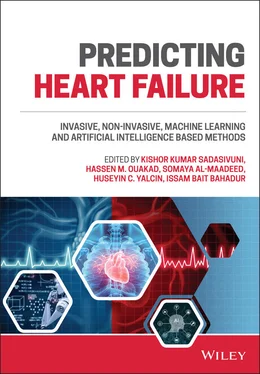Predicting Heart Failure
Здесь есть возможность читать онлайн «Predicting Heart Failure» — ознакомительный отрывок электронной книги совершенно бесплатно, а после прочтения отрывка купить полную версию. В некоторых случаях можно слушать аудио, скачать через торрент в формате fb2 и присутствует краткое содержание. Жанр: unrecognised, на английском языке. Описание произведения, (предисловие) а так же отзывы посетителей доступны на портале библиотеки ЛибКат.
- Название:Predicting Heart Failure
- Автор:
- Жанр:
- Год:неизвестен
- ISBN:нет данных
- Рейтинг книги:3 / 5. Голосов: 1
-
Избранное:Добавить в избранное
- Отзывы:
-
Ваша оценка:
- 60
- 1
- 2
- 3
- 4
- 5
Predicting Heart Failure: краткое содержание, описание и аннотация
Предлагаем к чтению аннотацию, описание, краткое содержание или предисловие (зависит от того, что написал сам автор книги «Predicting Heart Failure»). Если вы не нашли необходимую информацию о книге — напишите в комментариях, мы постараемся отыскать её.
Predicting Heart Failure: Invasive, Non-Invasive, Machine Learning and Artificial Intelligence Based Methods
Predicting Heart Failure
Predicting Heart Failure: Invasive, Non-Invasive, Machine Learning and Artificial Intelligence Based Methods
Predicting Heart Failure — читать онлайн ознакомительный отрывок
Ниже представлен текст книги, разбитый по страницам. Система сохранения места последней прочитанной страницы, позволяет с удобством читать онлайн бесплатно книгу «Predicting Heart Failure», без необходимости каждый раз заново искать на чём Вы остановились. Поставьте закладку, и сможете в любой момент перейти на страницу, на которой закончили чтение.
Интервал:
Закладка:
2.2.7 Chest Roentgenography
Despite the increasing number of modern diagnostic imaging techniques accessible to clinicians, chest roentgenography remains a straightforward, low-cost, and highly insightful examination. A roentgenogram, also known as an x-ray image is a photograph of internal structures made by moving x-rays through the body and forming a shadow image on specially sensitized film. Roentgenography was named after Wilhelm Conrad Röntgen, a German physicist who invented it in 1895. The chest x-ray is a reliable method for predicting pulmonary hemodynamic events in patients without chronic obstructive pulmonary disease and offers a fair estimation of pulmonary venous and arterial pressures. Unfortunately, the pulmonary vascular distribution of patients with chronic obstructive pulmonary disease may be substantially altered. This complicates roentgenographic assessment.
2.3 Physiological Values and Characteristics Considered for Clinical Examination
Apart from analyzing the symptoms and manifestations in the face, the physician or cardiologist examines several physiological values as well as characteristics to detect the presence of heart disease. This section briefly describes the physiological attributes/characteristics and values that aid the physician or cardiologist in diagnosing heart disease.
2.3.1 Exercise Capacity
Exercise capacity, also known as cardiorespiratory endurance, is the total amount of physical effort that a person can bear without discomfort. A precise evaluation of workout capacity requires the patient to exert maximal physical effort for an adequate enough time to reflect the stable effect on the circulation. The exercise capacity evaluation is one of the key characteristics for assessing the condition of the patient. Lower exercise capacity is linked with various risks including hypertension, cardiovascular disease, heart failure, etc. Many studies have shown the correlation between lower exercise capacity and acute health conditions [4]. Furthermore, the response of the cardiovascular system during exercise can identify heart diseases as well as mortality [5, 6].
The exercise capacity of an individual can be assessed either by a face-to-face interview or by using laboratory methods based on the available facilities in the clinic. In the face-to-face interview with the patient, the cardiologist will ask about any unprecedented events experienced during various daily activities, such as walking, running, or exercise. On the other hand, the laboratory methods include multiple tests, such as an exercise stress test, a cardiopulmonary exercise test, a 6-minute walk test, a submaximal treadmill test, etc.
2.3.2 Chest Pain or Discomfort
Chest pain or discomfort is the most common symptom found in adults for several reasons either serious or trivial. It occurs due to many causes, such as muscle strain, peptic ulcers, gastroesophageal reflux disease (GERD), asthma, etc. The pain or discomfort generated in the chest can be an important indication of possibly genuine cardiac or cardiovascular disorders. Proper care and treatment should be done early to identify the underlying cause of the chest pain and prevent it worsening. Regular exercise and healthy eating habits can greatly avoid getting chest pain.
Self-diagnosing chest pain based merely on symptoms is quite difficult. However, the frequency of pain and accompanying symptoms may help to shed light on the possible cause to some extent. The pain that arises from mild health issues including muscle strain, GERD, and asthma can last only for a few seconds and affect a specific point on the chest. Moreover, the pain is often relieved when the chest area is massaged, or after taking medication or a deep breath. Specifically, chest pain related to muscle strain gets better with massage and gets worse with sharp and sudden inhalation. Gastroesophageal reflux can cause chest pain which may be experienced shortly after a meal or consumption of alcohol. Sudden and intense pain that lasts longer than a few minutes can be an indicator of heart disease.
2.3.3 Palpitations
Palpitation generally refers to irregular and rapid heartbeats and can arise for a multitude of reasons. It can be caused by certain harmless conditions, such as strenuous exercise, lack of sleep, stress, anxiety, fear, etc., or it can be an alarming indication of certain illnesses relating to the heart, such as cardiac arrhythmia, which involve changes in heart rate and the contraction pattern. It can give the sensation that the heart has skipped, stopped, or added an extra beat, making us more aware of our heartbeat. Heart palpitations can become a significantly diagnosable characteristic in persons already diagnosed with heart failure or defective heart valves.
2.3.4 Dyspnea, Orthopnea, and Paroxysmal Nocturnal Dyspnea
Dyspnea is a condition where the patient suffers from shortness of breath or sometimes difficulty in breathing. Labored breathing, tightness in the chest, heart palpitations, and wheezing are often the indications of a person experiencing dyspnea. It can occur after intense exercise or from traveling to a high altitude. However, it can be directly related to severe health conditions such as pneumonia, heart failure, or low blood pressure. Dyspnea on exertion can be a normal occurrence unless it accompanies an activity that can be considered to be within the tolerance limits of the individual.
Since dyspnea is often characterized by the subjective experience or sensation reported by the patient, it is quite distinguishable from tachypnea, hyperventilation, and hyperpnea, which refer to respiratory variations. The latter conditions exist irrespective of the patients’ subjective sensations. Tachypnea is an increase in the respiratory rate, which is indicated by rapid shallow or deep breathing, often unnoticed by the patient. Hyperventilation is the increased and rapid breathing that occurs due to an unbalance between inhalation and exhalation. The increased exhalation results in reduced carbon dioxide levels in the blood, which in turn leads to the symptoms such as dizziness, shortness of breath, etc. Hyperpnea is also a condition of deep breathing but not necessarily faster. The forced respiration causes the inhalation of an increased air volume and the respiratory rate can even stay within normal limits. This is an indication of the body’s demand for more oxygen. These medical conditions might not always be associated with dyspnea.
The sensation of breathlessness that occurs only in the specific posture of lying down is referred to as orthopnea. It can result in tightness in the chest that makes breathing uncomfortable. However, it subsides when the patient stands upright or sits down. Still, it might be a symptom of heart or lung disease. The presence of increased heart rate, wheezing, or nausea along with orthopnea is an indicator for heart failure. A condition that is closely related to orthopnea is paroxysmal nocturnal dyspnea. It is a sensation of shortness of breath that makes the patient wake up after 1 or 2 hours of sleep. Similar to orthopnea, this condition is usually relieved after getting back to the upright position.
Apart from the aforementioned conditions of breathing difficulties, there are two uncommon types of breathlessness: trepopnea and platypnea. Trepopnea is typically dyspnea or breathlessness in either lateral decubitus position. The shortness of breath when lying on the left side can be attributed to chronic heart diseases. On the other hand, breathlessness experienced while lying on the right side may be due to a lung disease or a major bronchus. Platypnea is the reverse condition of orthopnea. This refers to breathlessness that occurs in the upright position (sitting or standing) and gets improved when lying down.
Читать дальшеИнтервал:
Закладка:
Похожие книги на «Predicting Heart Failure»
Представляем Вашему вниманию похожие книги на «Predicting Heart Failure» списком для выбора. Мы отобрали схожую по названию и смыслу литературу в надежде предоставить читателям больше вариантов отыскать новые, интересные, ещё непрочитанные произведения.
Обсуждение, отзывы о книге «Predicting Heart Failure» и просто собственные мнения читателей. Оставьте ваши комментарии, напишите, что Вы думаете о произведении, его смысле или главных героях. Укажите что конкретно понравилось, а что нет, и почему Вы так считаете.












